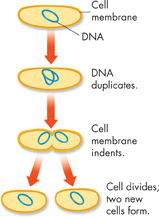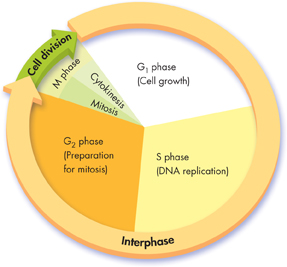The Prokaryotic Cell Cycle The prokaryotic cell cycle is a regular pattern of growth, DNA replication, and cell division that can take place very rapidly under ideal conditions. Researchers are only just beginning to understand how the cycle works in prokaryotes, and relatively little is known about its details. It is known that most prokaryotic cells begin to replicate, or copy, their DNA chromosomes once they have grown to a certain size. When DNA replication is complete, or nearly complete, the cell begins to divide.
The process of cell division in prokaryotes is a form of asexual reproduction known as binary fission. Once the chromosome has been replicated, the two DNA molecules attach to different regions of the cell membrane. A network of fibers forms between them, stretching from one side of the cell to the other. The fibers constrict and the cell is pinched inward, dividing the cytoplasm and chromosomes between two newly formed cells. Binary fission results in the production of two genetically identical cells.

FIGURE 10–6 Binary Fission Cell division in a single-celled organism produces two genetically identical organisms.
The Eukaryotic Cell Cycle In contrast to prokaryotes, much more is known about the eukaryotic cell cycle. As you can see in Figure 10–7, the eukaryotic cell cycle consists of four phases: G1, S, G2, and M. The length of each part of the cell cycle—and the length of the entire cell cycle—varies depending on the type of cell.
At one time, biologists described the life of a cell as one cell division after another separated by an “in-between” period of growth called interphase. We now appreciate that a great deal happens in the time between cell divisions. Interphase is divided into three parts: G1, S, and G2.
▸ G1 Phase: Cell Growth Cells do most of their growing during the G1 phase. In this phase, cells increase in size and synthesize new proteins and organelles. The G in G1 and G2 stands for “gap,” but the G1 and G2 phases are actually periods of intense growth and activity.
▸ S Phase: DNA Replication The G1 phase is followed by the S phase. The S stands for “synthesis.” During the S phase, new DNA is synthesized when the chromosomes are replicated. The cell at the end of the S phase contains twice as much DNA as it did at the beginning.

FIGURE 10–7 The Cell Cycle During the cell cycle, a cell grows, prepares for division, and divides to form two daughter cells. The cell cycle includes four phases—G1, S, G2, and M. Infer During which phase or phases would you expect the amount of DNA in the cell to change?
dTable of Contents
- Formulas and Equations
- Applying Formulas and Equations
- Mean, Median, and Mode
- Estimation
- Using Measurements in Calculations
- Effects of Measurement Errors
- Accuracy
- Precision
- Comparing Accuracy and Precision
- Significant Figures
- Calculating With Significant Figures
- Scientific Notation
- Calculating With Scientific Notation
- Dimensional Analysis
- Applying Dimensional Analysis




